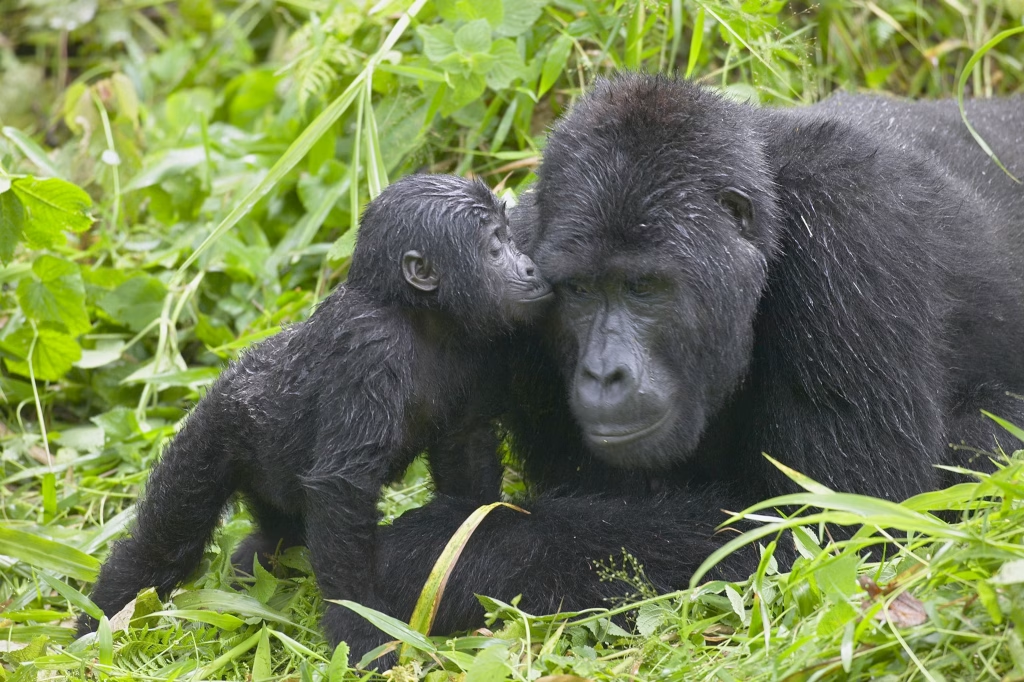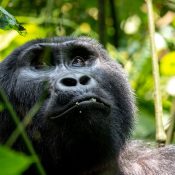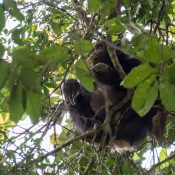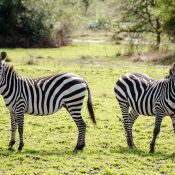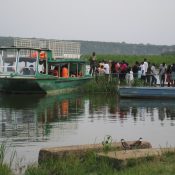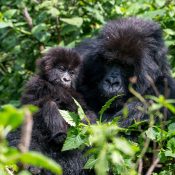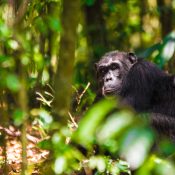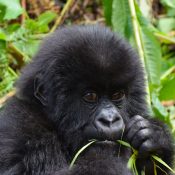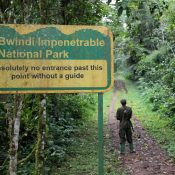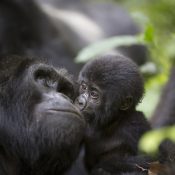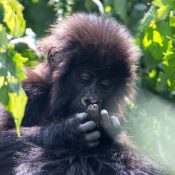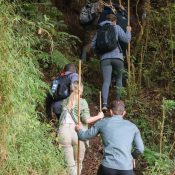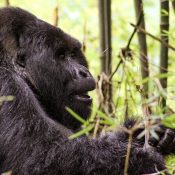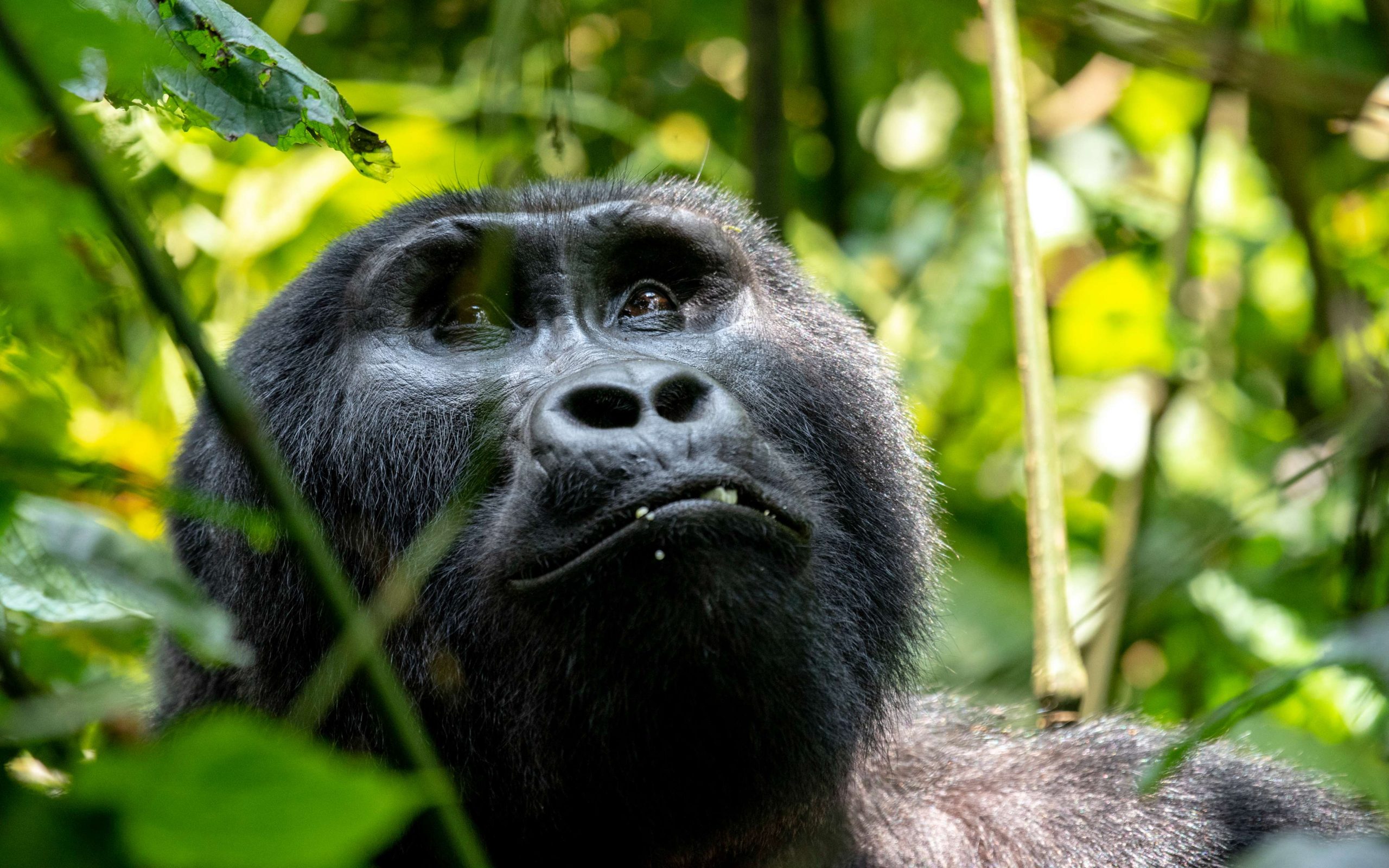
Imagine spending four uninterrupted hours in the presence of mountain gorillas—not as a passive observer, but as an active participant in their habituation process. This is the magic of the gorilla habituation experience in Bwindi Impenetrable Forest National Park, one of Uganda’s most exclusive and transformative wildlife encounters.
Bwindi Impenetrable Forest National Park, located in southwestern Uganda, is a UNESCO World Heritage Site and one of only a handful of places on Earth where you can encounter endangered mountain gorillas in their natural habitat. Gazetted in 1991 to protect these magnificent primates and their pristine tropical forest home, Bwindi has become a beacon for wildlife enthusiasts from around the globe.
Mountain gorillas share an astonishing 98% of their DNA with humans, making every encounter a profound reminder of our shared evolutionary heritage. While traditional gorilla trekking offers visitors one hour with habituated gorilla families, the gorilla habituation experience extends this precious time to four extraordinary hours, allowing you to witness the remarkable process of helping gorillas become comfortable with human presence.
What Makes Gorilla Habituation Different?
The gorilla habituation experience represents a significant departure from standard gorilla trekking. Rather than visiting fully habituated gorilla families that have already grown accustomed to tourists, habituation participants work alongside researchers, conservationists, and trackers who are actively training semi-habituated gorillas to tolerate human observers.
This immersive experience available in Bwindi’s Rushaga and Nkuringo sectors gives you unprecedented access to the daily lives of mountain gorillas. You’ll observe intimate behaviors that casual trekkers rarely witness and contribute to vital conservation work that ensures these endangered primates can be studied and protected for generations to come.
The Gorilla Habituation Experience: What to Expect
Morning Briefing and Preparation
Your adventure begins early in the morning at the sector offices in either Rushaga or Nkuringo. Here, you’ll join a small, exclusive group of fellow adventurers—the gorilla habituation experience is limited to just four participants per session, ensuring minimal impact on the gorillas and maximum quality time for each visitor.
During the comprehensive briefing, experienced park rangers will explain the habituation process, outline behavioral guidelines, and share insights about the specific gorilla family you’ll be visiting. You’ll learn proper etiquette: maintaining a seven-meter distance, avoiding direct eye contact that might be perceived as threatening, and suppressing coughs or sneezes to prevent disease transmission.
Into the Impenetrable Forest
Armed ranger guides will lead your small group into Bwindi’s legendary “impenetrable” forest—a name that becomes immediately understandable as you navigate through dense vegetation, steep slopes, and tangled undergrowth. Unlike standard gorilla treks, you’ll be accompanied not just by rangers but also by researchers, conservationists, and expert trackers who spend their days monitoring gorilla movements and behaviors.
The search for your assigned gorilla family can take anywhere from two to seven hours, depending on where the gorillas nested the previous night and how far they’ve traveled since dawn. Mountain gorillas are constantly on the move, foraging for food and exploring their territory, so each trek presents unique challenges and rewards.
Four Magical Hours with Mountain Gorillas
The moment you locate the gorilla family, your four-hour habituation experience officially begins. This is where the true magic unfolds. Unlike the somewhat passive observation of regular gorilla trekking, habituation allows you to witness the delicate process of building trust between humans and these magnificent creatures.
Rangers and researchers employ gentle, non-threatening approaches to gain the gorillas’ acceptance. You’ll watch as they make soft vocalizations, avoid sudden movements, and gradually reduce the distance between themselves and the gorilla family. As a participant, you become part of this careful dance, learning firsthand how patience and respect forge connections across species.
During your four hours, you’ll observe an incredible range of natural behaviors. Watch silverback leaders maintain order within their groups, mothers tenderly nursing and grooming their infants, juveniles tumbling and playing with infectious enthusiasm, and family members foraging for favorite foods like bamboo shoots and wild celery. You might witness nest-building as gorillas prepare for their midday rest, or observe complex social interactions that reveal the deep emotional bonds within gorilla families.
Active Participation in Conservation
What truly distinguishes the habituation experience is your role as an active participant rather than a spectator. Researchers may explain what specific behaviors mean, share data they’re collecting, or point out individual gorillas’ unique personalities and positions within the family hierarchy. You’ll gain insights into the scientific work that protects these endangered primates while contributing to their conservation simply through your presence and participation in the habituation process.
The extended time allows for exceptional photography opportunities, though you’ll need to balance your desire for the perfect shot with the primary goal of allowing gorillas to become comfortable with human observers. Many participants find that the most rewarding moments come not through a camera lens but through direct, unmediated observation of these extraordinary beings.
Essential Packing List
Bwindi’s mountain forest environment demands proper preparation. Here’s what you’ll need for a successful gorilla habituation experience:
Clothing:
- Long-sleeved shirts and pants (protects against vegetation, insects, and stinging nettles)
- Waterproof hiking boots with excellent ankle support and grip
- Long cotton or wool socks
- Rain jacket or poncho (weather can change quickly at altitude)
- Warm sweater or fleece layer (mornings can be cool at 2,000+ meters elevation)
- Gardening gloves (invaluable when grabbing vegetation on steep sections)
Equipment:
- Lightweight, comfortable backpack
- Camera with appropriate settings for forest light conditions (no flash allowed)
- Binoculars for distant wildlife and bird watching
- Walking stick (often provided by the park, but you can bring your own)
Essentials:
- Insect repellent (preferably DEET-based)
- Sunscreen
- Refillable water bottles (stay well-hydrated during the long trek)
- Energy-rich snacks (nuts, dried fruit, chocolate, energy bars)
- Packed lunch (provided by most lodges, or arrange with your tour operator)
- Personal first-aid supplies and any necessary medications
Permit Costs and Booking Information
The gorilla habituation experience requires a special permit issued exclusively by Uganda Wildlife Authority. Due to the activity’s intimate nature and limited daily slots (only four participants per gorilla family), these permits are highly sought after and require advance booking.
Current Permit Prices:
- Foreign non-residents: $1,500 per person
- Foreign residents: $1,000 per person
- East African citizens: UGX 250,000 per person
Booking Timeline:
If you’re planning to visit during the dry season (peak tourism periods), book your permit at least three to six months in advance. These permits sell out quickly, especially during June through September and December through February. Last-minute bookings are occasionally possible during the rainy season, but advance planning is always recommended.
You can book permits directly through Uganda Wildlife Authority or work with a reputable tour operator who can coordinate permits, accommodation, and transportation as part of a comprehensive safari package.
Best Time for Gorilla Habituation
Dry Season (June to September and December to February)
The dry season represents the optimal time for gorilla habituation in Bwindi for several compelling reasons:
- Trail Conditions: Reduced rainfall means trekking paths remain relatively dry and stable, making the challenging terrain more manageable.
- Visibility: Vegetation is less dense, offering clearer views of gorillas and better photography conditions.
- Road Access: Routes to and within the park remain in good condition, ensuring smooth transfers.
- Weather Predictability: While rain is still possible at any time in a tropical mountain forest, it’s less frequent and intense during dry months.
Rainy Season (March to May and October to November)
The wet season presents both challenges and unique advantages:
Challenges:
- Heavy rainfall creates muddy, slippery trails that slow trekking pace
- Dense vegetation can obscure views and complicate photography
- Road conditions may deteriorate, particularly on unpaved access routes
- Rain gear becomes essential daily equipment
Advantages:
- Fewer tourists mean more availability and a more exclusive experience
- The forest is at its most lush and vibrant
- Birdlife is particularly active and visible
- Some lodges offer discounted rates
- Gorillas tend to move less in wet weather, potentially shortening search times
Regardless of season, Bwindi’s equatorial location ensures relatively mild temperatures year-round, though mornings and evenings can be cool at the park’s 1,160 to 2,607-meter elevation range.
Where to Stay
Since gorilla habituation operates exclusively in the Rushaga and Nkuringo sectors, your accommodation should be located in or near these areas to minimize early morning travel time.
Luxury Lodges:
- Clouds Mountain Gorilla Lodge (exceptional views and world-class service)
- Four Gorillas Lodge (intimate setting with modern amenities)
- Nkuringo Bwindi Gorilla Lodge (stunning valley views)
- Chameleon Hill Lodge (boutique luxury experience)
Mid-Range Options:
- Lake Mulehe Gorilla Lodge (lakeside setting with comfortable rooms)
- Gorilla Valley Lodge (excellent value with good facilities)
- Ichumbi Gorilla Lodge (community-run with authentic local experience)
Budget-Friendly:
- Gorilla Heights Lodge (basic but clean accommodation near Rushaga)
Most lodges arrange packed breakfasts and lunches for gorilla habituation participants, along with transfer services to the sector offices. Many also offer additional activities like community walks, bird watching, and cultural performances to enhance your stay.
Getting to Bwindi Impenetrable Forest National Park
By Road from Kampala:
The journey to Bwindi’s southern sectors (Rushaga and Nkuringo) takes approximately 8-10 hours via the Kampala-Masaka-Mbarara-Kabale route. Most visitors break the journey with an overnight stop in Kabale or Lake Bunyonyi, just an hour from the park.
By Air:
For those preferring to minimize travel time, scheduled and charter flights operate from Entebbe International Airport to Kihihi Airstrip (serving northern sectors) or Kisoro Airstrip (serving southern sectors including Rushaga and Nkuringo). Flight time is approximately one hour, followed by a 1-2 hour road transfer to your lodge.
Conservation Impact and Responsible Tourism
Your participation in the gorilla habituation experience directly supports mountain gorilla conservation. Permit fees fund anti-poaching patrols, veterinary care, habitat protection, and community programs that reduce human-wildlife conflict. The habituation process itself is essential for research, allowing scientists to study gorilla behavior, health, and population dynamics while minimizing stress on fully wild populations.
By following guidelines—maintaining proper distance, limiting group size, and respecting gorilla space—you help ensure these critically endangered primates continue to thrive. Your visit also demonstrates to local communities that mountain gorillas have greater value alive than through any alternative land use, creating economic incentives for conservation.
Final Thoughts: An Experience Beyond Comparison
The gorilla habituation experience in Bwindi Impenetrable Forest National Park ranks among the world’s most exclusive and meaningful wildlife encounters. Those four hours in the presence of mountain gorillas—watching them feed, play, rest, and interact—create memories and insights that last a lifetime.
This isn’t simply wildlife viewing; it’s an immersive journey into the complex social world of our closest living relatives. It’s contributing to cutting-edge conservation science. It’s standing in a primeval forest and feeling the weight of evolutionary history. It’s understanding, perhaps for the first time, just how interconnected all life truly is.
Whether you’re a seasoned safari enthusiast, a wildlife photographer, a conservation supporter, or simply someone seeking an authentic connection with nature, the gorilla habituation experience delivers something profound and transformative. Start planning your journey to Bwindi today—the mountain gorillas are waiting.
Talk to our experts
Recent Posts
African Buffalo: The Unpredictable Giant of the Savannah
Gorilla Habituation in Bwindi Impenerable Park
Chimpanzee Trekking in Kyambura Gorge: The Ultimate Guide
Discover Lake Mburo National Park: Your Ultimate Safari Adventure Guide
Kazinga channel boat cruise
Uganda Gorilla Tours.
Chimpanzee trekking in Uganda.
Gorilla Trekking in Uganda.
Gorilla Trekking Guide for Bwindi and Mgahinga National Parks (2025
Essential Packing List for Your Gorilla Trekking Adventure in Uganda (2025 Guide)
Gorilla Trekking Rules
Gorilla Trekking Tours: Exploring the World of Mountain Gorillas
10 Essential Facts About Mountain Gorillas for Trekking Enthusiasts
Where do mountain gorillas live
What you need to know about Silverback Gorillas
Booking Gorilla Trekking Permit
Ceremonial naming of a gorilla in Rwanda
Tags
Start Planning
Info@inmotiongorillasafaris.com
TALK TO AN EXPERT
Explore breathtaking destinations, unique cultural experiences, and unforgettable journeys. Start your adventure today with our tailored travel packages.
